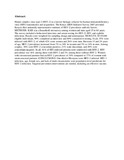Prevalence of herpes simplex virus type 2 infection, human immunodeficiency virus/herpes simplex virus type 2 coinfection, and associated risk factors in a national, population-based survey in Kenya.

View/
Date
2011Author
Mugo, N
Dadabhai, SS
Bunnell, R
Williamson, J
Bennett, E
Baya, I
Akinyi, N
Mohamed, I
Kaiser, R
Type
ArticleLanguage
enMetadata
Show full item recordAbstract
Herpes simplex virus type 2 (HSV-2) is a known biologic cofactor for human immunodeficiency virus (HIV) transmission and acquisition. The Kenya AIDS Indicator Survey 2007 provided Kenya's first nationally representative estimate of HSV-2 prevalence and risk factors.
METHODS:
KAIS was a household serosurvey among women and men aged 15 to 64 years. The survey included a behavioral interview and serum testing for HSV-2, HIV, and syphilis infections. Results were weighted for sampling design and nonresponse.
RESULTS:
Of 19,840 eligible individuals, 90% completed an interview and 80% consented to testing. In all, 35% were infected with HSV-2, of which 42% were women and 26% were men. Between 15 and 24 years of age, HSV-2 prevalence increased from 7% to 34% in women and 3% to 14% in men. Among couples, 30% were HSV-2 concordant-positive, 21% were discordant, and 49% were concordant-negative. In all, 81% of HIV-infected persons were coinfected with HSV-2. HIV prevalence was 16% among those with HSV-2 and 2% among those without HSV-2. Women with circumcised partners had an HSV-2 prevalence of 39% compared to 77% of women with uncircumcised partners.
CONCLUSIONS:
One-third of Kenyans were HSV-2 infected. HIV-1 infection, age, female sex, and lack of male circumcision were population-level predictors for HSV-2 infection. Targeted prevention interventions are needed, including an effective vaccine.
URI
http://hinari-gw.who.int/whalecomwww.ncbi.nlm.nih.gov/whalecom0/pubmed/21992985http://erepository.uonbi.ac.ke:8080/xmlui/handle/123456789/32715
Citation
Prevalence of herpes simplex virus type 2 infection, human immunodeficiency virus/herpes simplex virus type 2 coinfection, and associated risk factors in a national, population-based survey in Kenya. Mugo N, Dadabhai SS, Bunnell R, Williamson J, Bennett E, Baya I, Akinyi N, Mohamed I, Kaiser R. Sex Transm Dis. 2011 Nov;38(11):1059-66. doi: 10.1097/OLQ.0b013e31822e60b6.Publisher
Gynaecology, Kenyatta National Hospital, Nairobi, Kenya.
Collections
- Faculty of Health Sciences (FHS) [10415]
